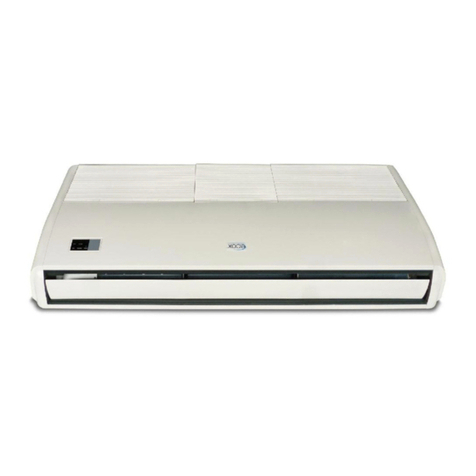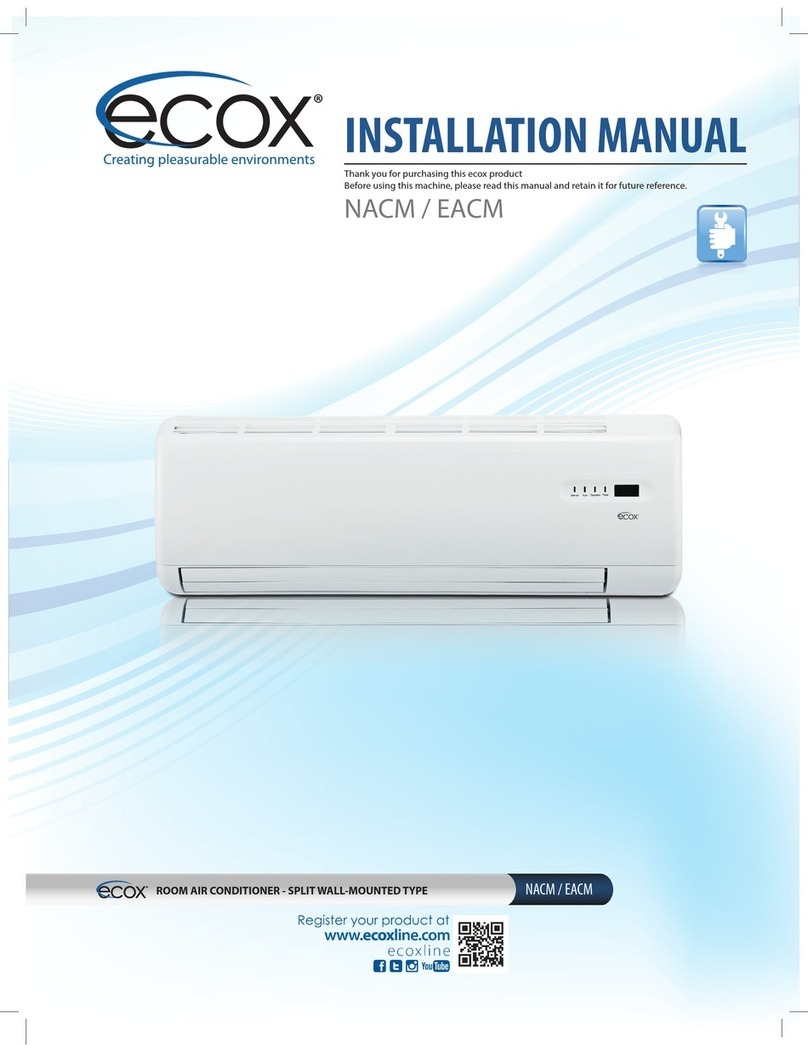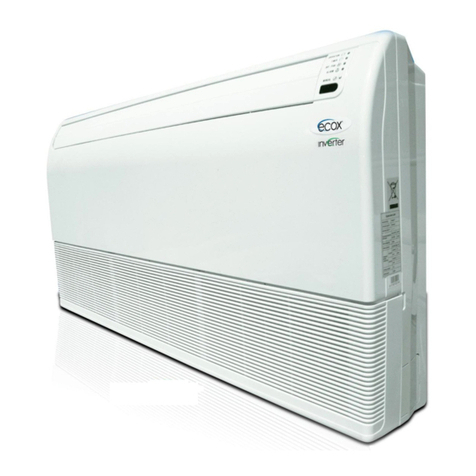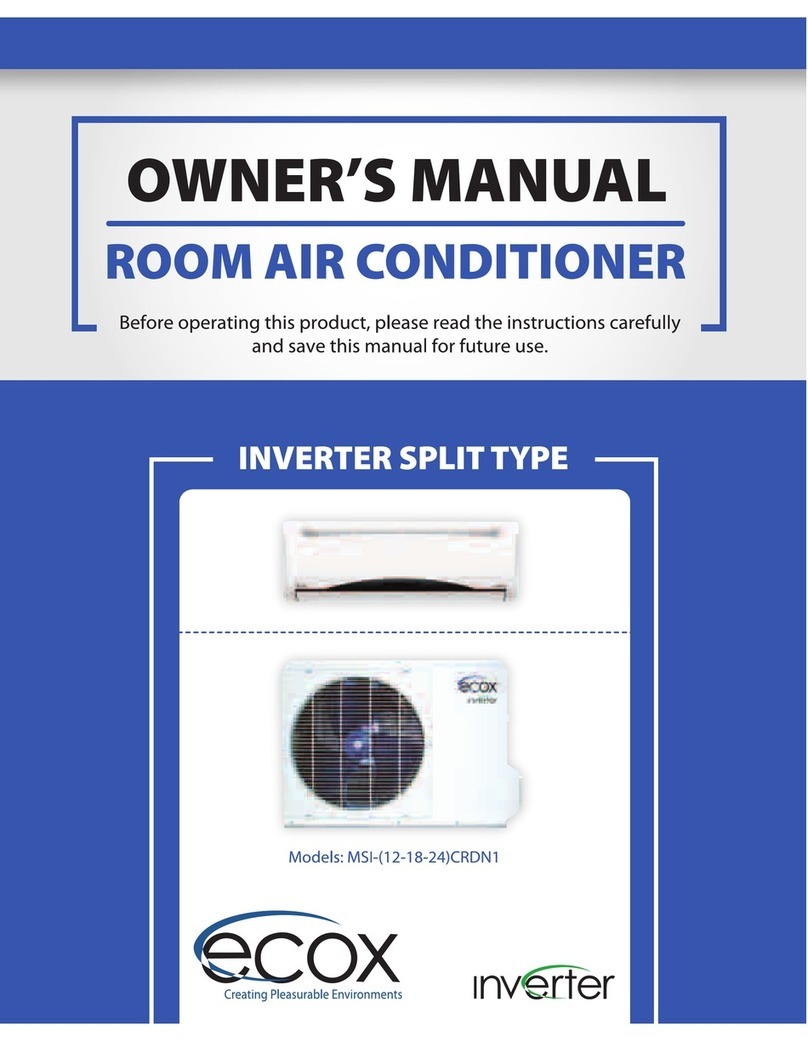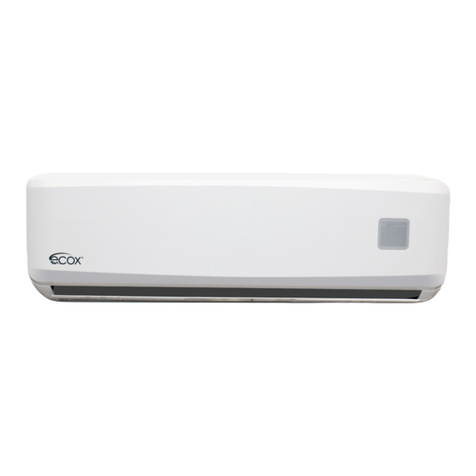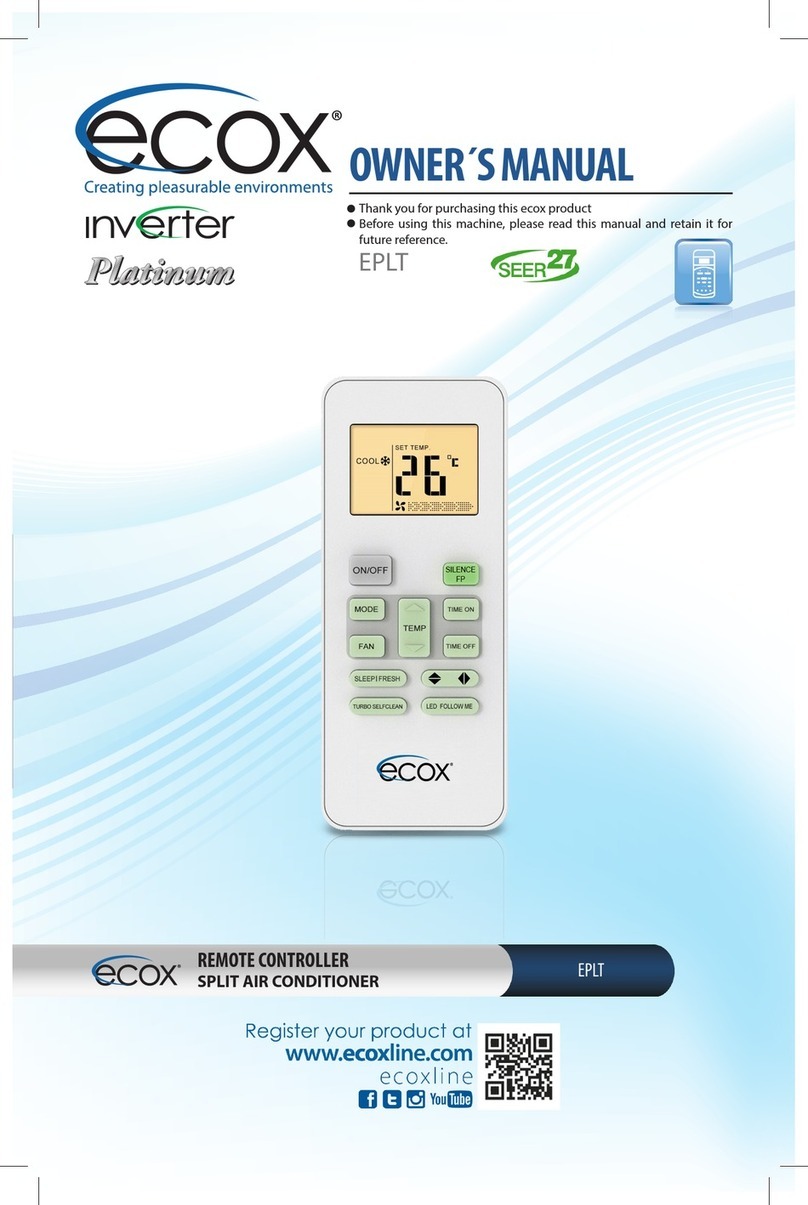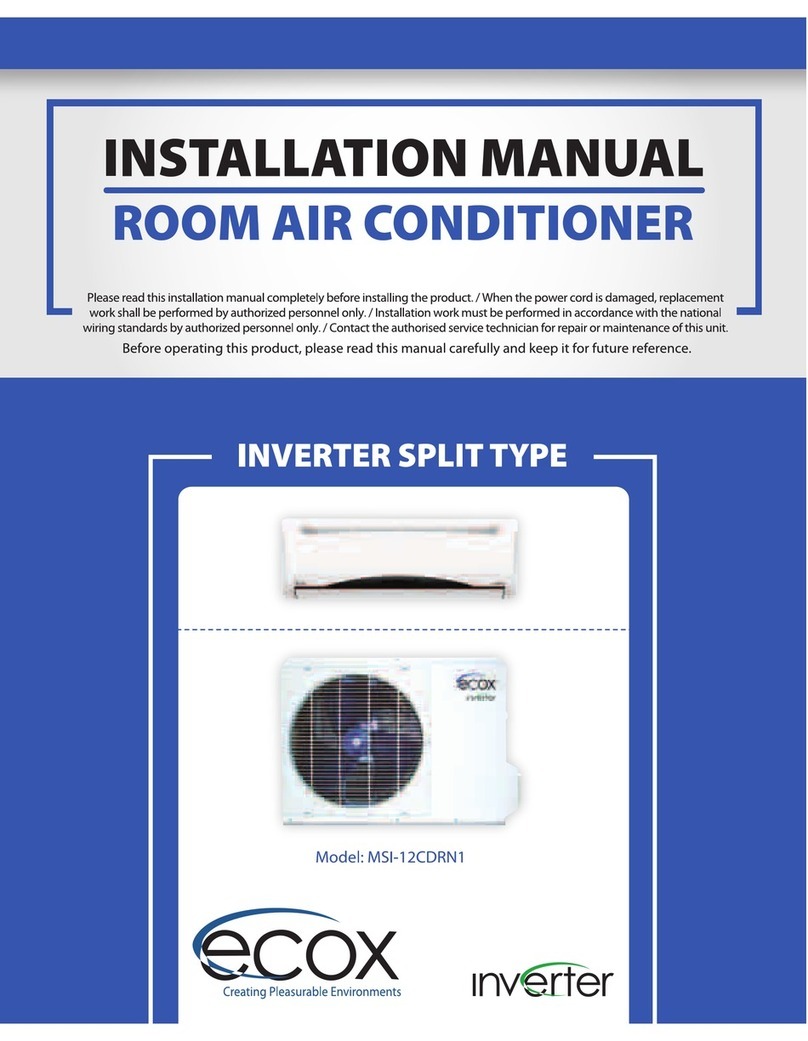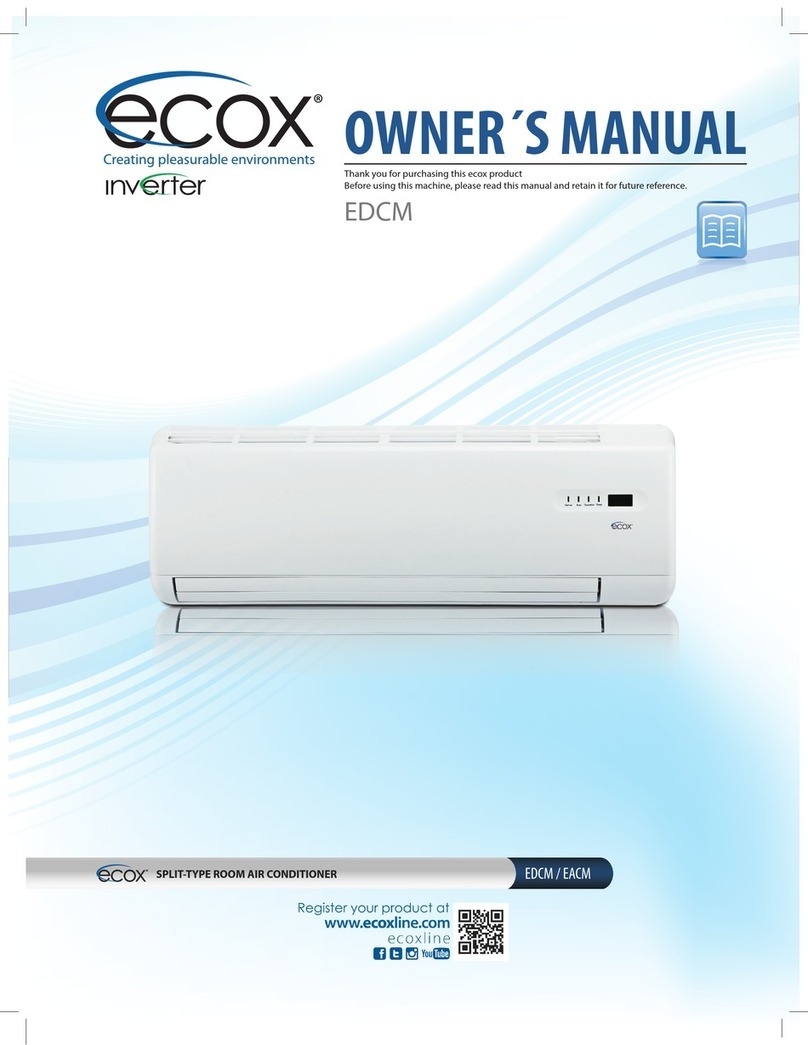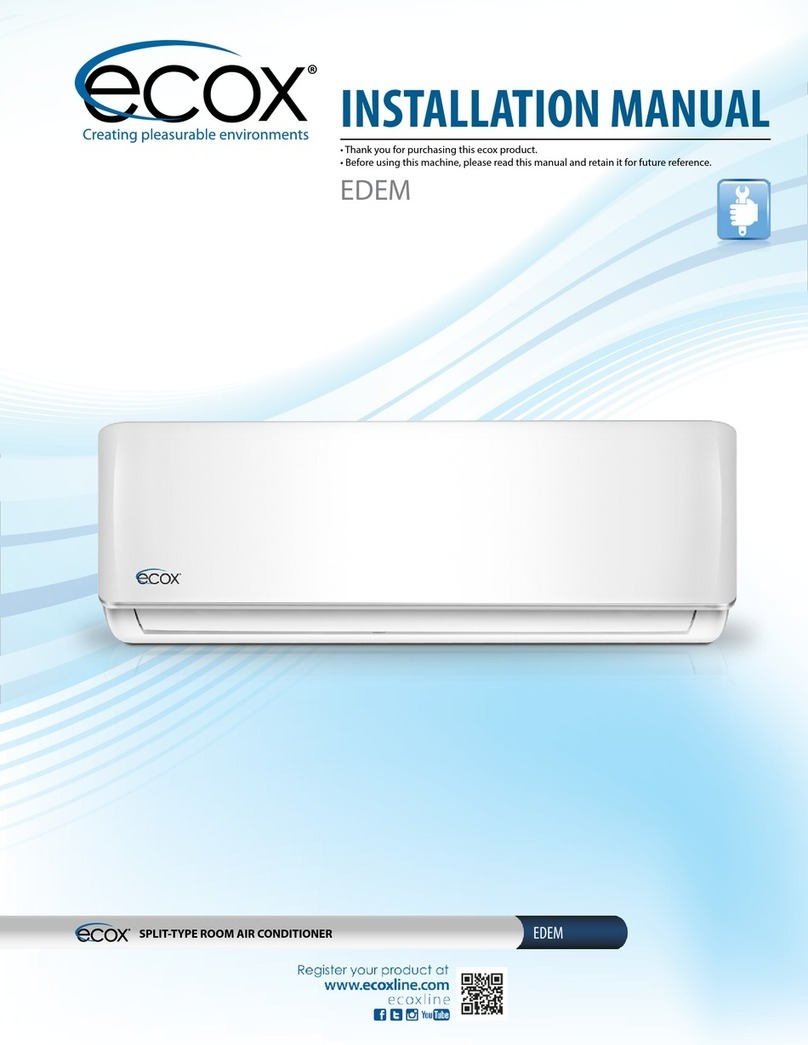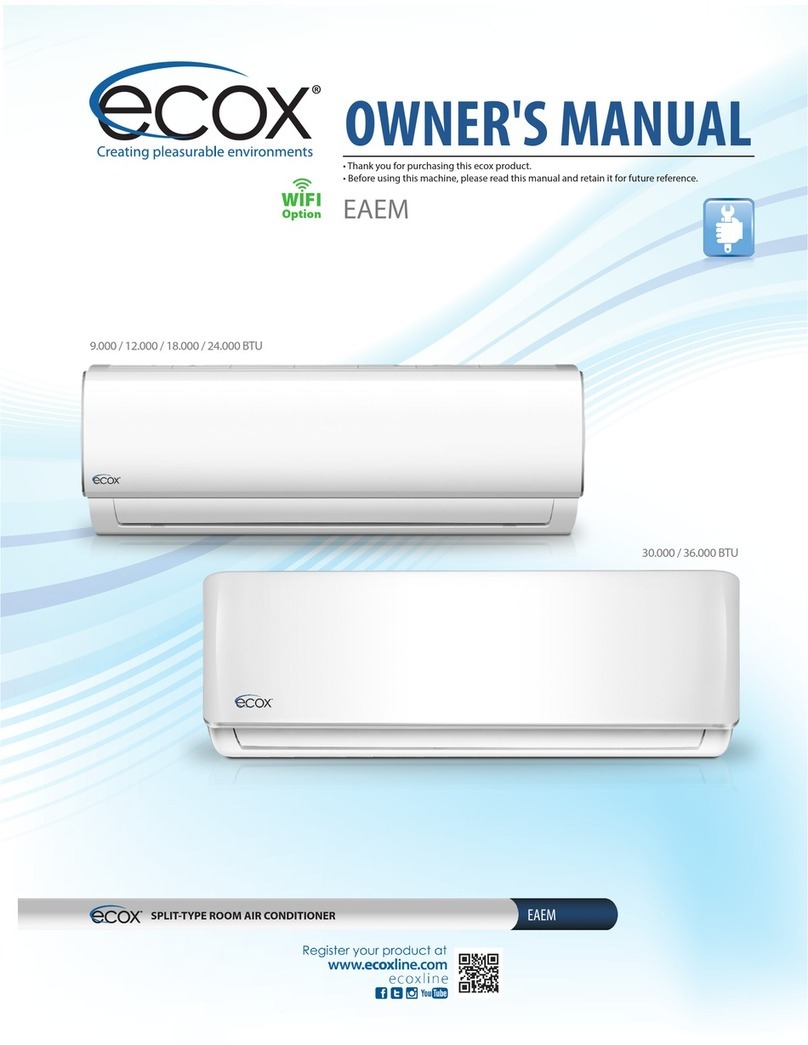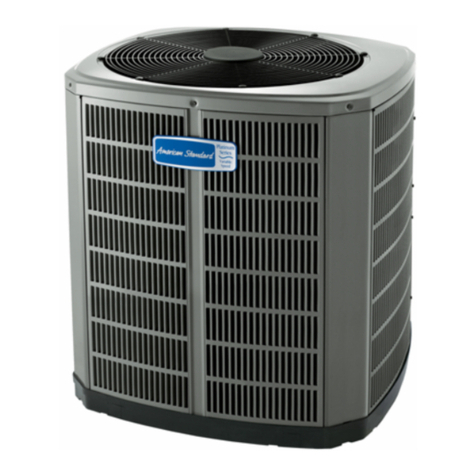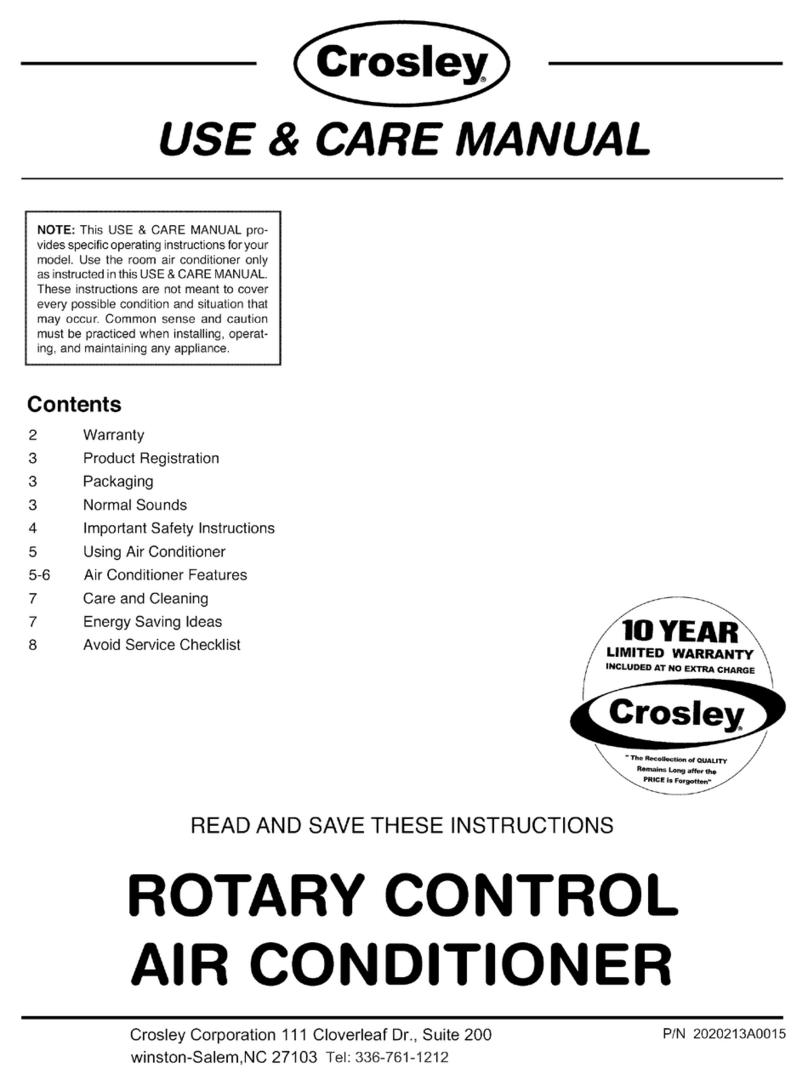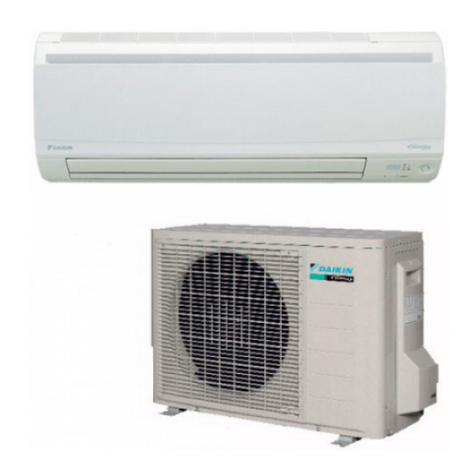Ecox EIHPTC User manual

CEILING FLOOR TYPE
• Thank you for purchasing this ecox product.
• Before using this machine, please read this manual and retain it for future reference.
INSTALLATION MANUAL
EIHPTC
EIHPTC

2
EIHPTC CEILING FLOOR TYPE
PRECAUTIONS
INSTALLATION INFORMATION
ATTACHED FITTINGS
INSPECTING AND HANDLING THE UNIT
INDOOR UNIT INSTALLATION
OUTDOOR UNIT INSTALLATION
INSTALL THE CONNECTING PIPE
CONNECT THE DRAIN PIPE
WIRING
TEST OPERATION
CONTENTS
3
2
4
9
4
4
13
6
CAUTION
PRECAUTIONS
If you do not follow these instrutions exactly, the unit may cause
property damage, personal injury or loss of life.
If you do not follow these instrutions exactly, the unit may cause
minor or moderate property damage, personal injury.
After completing the installation, make sure that the unit operates
properly during the start-up operation. Please instruct the
customer on how to operate the unit and keep it maintained. Also,
inform customers that they should store this installation manual
along with the owner's manual for future reference.
Be sure only trained and qualied service personnel to install,
repair or service the equipment.
Improper installation, repair, and maintenance may result in
electric shocks, short-circuit, leaks, re or other damage to the
equipment.
keep this manual where the operator can easily nd them.
Read this manual attentively before starting up the units.
For safety reason the operator must read the following
cautions carefully.
Installation must be performed in accordance with the
requirement of NEC and CEC by authorized personnel only.
(Applicable to the North American area only).
The safty precautions listed here are divided into two categories.
Install according to this installation instructions strictly.
If installation is defective, it will cause water leakage, electrical
shock and re.
When installing the unit in a small room, take measures against
to keep refrigerant concentration from exceeding allowable
safety limits in the event of refrigerant leakage.
Contact the place of purchase for more information. Excessive
refrigerant in a closed ambient can lead to oxygen deciency.
Use the attached accessories parts and specied parts or
installation.
Otherwise, it will cause the set to fall, water leakage, electrical
shock and re.
Install at a strong and rm location which is able to withstand
the set' s weight.
If the strength is not enough or installation is not properly done,
the set will drop to cause injury.
The appliance shall not be installed in the laundry.
Before obtaining access to terminals, all supply circuits must be
disconnected.
The appliance must be positioned so that the plug is accessible.
The enclosure of the appliance shall be marked by word, or by
symbols, with the direction of the uid ow.
For electrical work, follow the local national wiring standard,
regulation and this installation instructions. An independent
circuit and single outlet must be used.
If electrical circuit capacity is not enough or defect in electrical
work, it will cause electrical shock re.
Use the specied cable and connect tightly and clamp the cable
so that no external force will be acted on the terminal.
If connection or xing is not perfect, it will cause heat-up or re at
the connection.
Wiring routing must be properly arranged so that control board
cover is xed properly.
If control board cover is not xed perfectly, it will cause heat-up at
connection point of terminal, re or electrical shock.
If the supply cord is damaged, it must be replaced by the
manufacturer or its service agent or a similarly qualied person
in order to avoid a hazard.
An all-pole disconnection switch having a contact separation of
at least 3mm in all poles should be connected in xed wiring.
When carrying out piping connection, take care not to let air
substances go into refrigeration cycle.
Otherwise, it will cause lower capacity, abnormal high pressure in
the refrigeration cycle, explosion and injury.
Do not modify the length of the power supply cord or use of
extension cord, and do not share the single outlet with other
electrical appliances.
Otherwise, it will cause re or electrical shock.
12
14
WARNING
WARNING

3
EIHPTC
CEILING FLOOR TYPE
CAUTION
Carry out the specied installation work after taking into
account strong winds, typhoons or earthquakes.
Improper installation work may result in the equipment falling and
causing accidents.
If the refrigerant leaks during installation, ventilate the area
immediately.
Toxic gas may be produced if the refrigerant comes into the place
contacting with re.
The temperature of refrigerant circuit will be high, please keep
the interconnection cable away from the copper tube.
After completing the installation work, check that the
refrigerant does not leak.
Toxic gas may be produced if the refrigerant leaks into the room
and comes into contact with a source of re, such as a fan heater,
stove or cooker.
Ground the air conditioner.
Do not connect the ground wire to gas or water pipes, lightning
rod or a telephone ground wire. Inapropriate grounding may
result in electric shocks.
Be sure to install an earth leakage breaker.
Failure to install an earth leakage breaker may result in electric
shocks.
Connect the outdoor unit wires , then connect the indoor unit
wires.
You are not allowed to connect the air conditioner with the power
supply until the wiring and piping is done.
While following the instructions in this installation manual,
install drain piping in order to ensure proper drainage and
insulate piping in order to prevent condensation.
Improper drain piping may result in water leakage and property
damage.
Install the indoor and outdoor units, power supply wiring
and connecting wires should be at least 1 meter away from
televisions or radios in order to prevent image interference or
noise.
Depending on the radio waves, a distance of 1 meter may not be
sucient enough to eliminate the noise.
The appliance is not intended for use by young children or inrm
persons without supervision.
Don't install the air conditioner in the following circumstance:
There is petrolatum existing.
There is salty air surrounding (Near the coast).
There is caustic gas (The sulde, for example) existing in the air
(Near a hot spring).
The Volt vibrates violently (In the factories).
In buses or cabinets.
In kitchen where it is full of oil gas.
There is strong electromagnetic wave existing.
There are inammable materials or gas.
There is acid or alkaline liquid evaporating.
Other special conditions.
The appliance shall be installed in accordance with national
wiring regulations.
Do not operate your air conditioner in a wet room such as a
bathroom or laundry room.
An all-pole disconnection device which has at least 3mm
clearances in all poles, and have a leakage current that may
exceed 10mA, the residual current device (RCD) having a
rated residual operating current not exceeding 30mA, and
disconnection must be incorporated in the xed wiring in
accordance with the wiring rules.
INSTALLATION INFORMATION2.
To install properly, please read this "installation manual" at rst.
The air conditioner must be installed by qualied persons.
When installing the indoor unit or its tubing, please follow this
manual as strictly as possible.
If the air conditioner is installed on a metal part of the building,
it must be electrically insulated according to the relevant
standards to electrical appliances.
When all the installation work is nished, please turn on the
power only after a thorough check.
Regret for no further announcement if there is any change of
this manual caused by product improvement.
INSTALLATION ORDER
Select the location.
Install the indoor unit.
Install the outdoor unit.
Install the connecting pipe.
Connect the drain pipe.
Wiring.
Test operation.

4
EIHPTC CEILING FLOOR TYPE
ATTACHED FITTINGS3.
INSPECTING AND HANDLING THE UNIT4.
At delivery, the package should be checked and any damage
should be reported immediately to the the
service agent.
When handling the unit, take into account the following:
Fragile, handle the unit with care.
Keep the unit upright in order to avoid compressor damage.
Choose on before hand the path along which the unit is to be
brought in.
Move this unit as originally package as possible.
When lifting the unit , always use protectors to prevent belt
damage and pay attention to the position of the unit’s centre
of gravity.
1
2
3
4
INDOOR UNIT INSTALLATION5.
5.1 Installation place
(Refer to Fig. 5-1, Fig. 5-2 and Table 5-1 for specication).
The indoor unit should be installed in a location that meets
the following requirements:
There is enough room for installation and maintenance.
The ceiling is horizontal, and its structure can endure the weight
of the indoor unit.
The outlet and the inlet are not impeded, and the inuence of
external air is the least.
The air ow can reach throughout the room.
CAUTION
Keep indoor unit, outdoor unit, power supply wiring and
transmission wiring at least 1 meter away from televisions and
radios. This is to prevent image interference and noise in those
electrical appliances. (Noise may be generated depending on the
conditions under which the electric wave is generated, even if 1
meter is kept.)
QUANTITYSHAPENAME
5. Owner's manual
6. Installation manual
7. Remote controller manual
1. Remote controller
(on some models)
2. Remote controller holder
(on some models)
4. Alkaline dry batteries (AM4)
1
1
2
2
1
1
Remote controller & Its Holder
Others
3. Mounting screw(ST2.9×
10-C-H)
1
The connecting pipe and drainpipe could be extracted out
easily.
There is no direct radiation from heaters.
Fig.5-1
5.2 Install the main body
B
E. Connecting point of
refrigerant pipe
(D. gas side)
D. Connecting point of
refrigerant pipe
(E. Liquid side)
Drain point
Fig. 5-2
C
D
Hook
Installing Ø10 hanging screw bolts. (4 bolts)
Please Refer to Fig.5-3 and Fig.5-4 for the hanging screw
bolts distance
Evaluate the ceiling construction and please install with Ø10
hanging screw bolts.
The handling to the ceiling varies from the constructions,
consult the construction person for the specic condition.
1

5
EIHPTC
CEILING FLOOR TYPE
• Do keep the ceiling at. Consolidate the roof beam to avoid
possible vibration.
• Cut o the roof beam.
• Strengthen the place that has been cut o, and consolidate
the roof beam.
After the selection of installation location, position the
refrigerant pipes, drain pipes,indoor & outdoor wires to the
connection places before hanging up the machine.
The installation of hanging screw bolts.
WOODEN CONSTRUCTION
Put the square timber traversely overthe roof beam, then install
the hanging screw bolts.
NEW CONCRETE BRICKS
Inlaying or embedding the screw bolts.
FOR ORIGINAL CONCRETE BRICKS
Install the hanging hook with expansible bolt into the concrete
deep to 45~50mm to prevent loose.
STEEL ROOF BEAM STRUCTRUE
Install and use directly the supporting angle steel.
Fig.5-3
Roof beam
Hanging screw bolts
Ceiling
Timber over the beam
Fig.5-4
Fig.5-5
Steel bar
Embedding screw bolt
(Pipe hanging and embedding screw bolt)
(Blade shape
insertion)
(Slide insertion)
Fig.5-6
Fig.5-7
Hanging screw bolt
Hanging
bolts
Supporting
angle steel
Fig.5-8
Side board
Grille
Hanging arm
Hanging
screw bolt
Screw nut
Washer
Hanging
screw bolt
Hanging arm
Fig.5-9
20 25mm
20mm
Fig. 5-10
D. Connecting point of refrigerant pipe
(D.gas side)
Drain point
Downward declicity lower between(1-2)/100
E. Connecting point of refrigerant pipe
(E. Liquid side)
Fig. 5-11
Fig. 5-12
2
3
Install the indoor unit.
Remove the side board and the grille. (Refer to Fig. 5-8)
Locate the hanging arm on the hanging screw bolt.
(Refer to Fig. 5-9)
Ceiling Installation
Wall Mounting Installation
4

6
EIHPTC CEILING FLOOR TYPE
5.3 The dimension of the unit
mm
MODEL
30~48
18~24
A B D EC
1068 675 235 983
60
220675 235 1565
1650
220
1285 675 235 1200 220
36~48
220675 235 1565
1650
OUTDOOR UNIT INSTALLATION6.
6.1 Installation Place
The outdoor unit should be installed in the location that
meets the following requiements:
There is enough room for installation and maintenance.
The air outlet and the air inlet are not impeded, and can not be
reached by strong wind.
It must be a dry and well ventilating place.
The support is at and horizontal and can stand the weight of
the outdoor unit. And will no additional noise or vibration.
Your neighborhood will not feel uncomfortable with the noise
or expelled air.
It is easy to install the connecting pipes or cables.
Determine the air outlet direction where the discharged air is
not blocked.
There is no danger of re due to leakage of inamable gas.
The piping length between the outdoor unit and the indoor
unit may not exceed the allowable piping length.
In the case that the installation place is exposed to strong
wind such as a seaside, make sure the fan operating properly
by putting the unit lengthwise along the wall or using a dust
shield. (Refer to Fig. 6-1).
If possible, do not install the unit where it is exposed to direct
sunlight.
If necessary, install a blind that does not interfere with the air
ow.
During the heating mode, the water drained o the outdoor
unit. The condensate should be well drained away by the drain
hole to an appropriate place, so as not to interfere other people.
Select the position where it will not be subject to snow drifts,
accumulation of leaves or other seasonal debris. If unavoidable,
please cover it with a shelter.
Locate the outdoor unit as close to the indoor unit as possible.
X
O
Fig.6-1
Strong WInd
If possible, please remove the obstacles nearby to prevent the
performance from being impeded by too Little of air circulation.
The minimum distance between the outdoor unit and obstacles
described in the installation chart does not mean that the same
is applicable to the situation of an airtight room. Leave open
two of the three directions. (M,N,P) (Refore to Fig. 6-7, Fig. 6-8,
Fig. 6-9).
NOTE
The dimension of 12 and 24 are the same.
The dimension of 30 and 36 are the same.
The dimension of 48 and 60 are the same.
6.2 Figure of body size
Split type outdoor unit
1
Fig.6-2
Fig.6-3
Fig.6-4
B
C
D
E
F
A
H
H
A
Table 5-1

7
EIHPTC
CEILING FLOOR TYPE
1-6elbaT mm
845 560 335 360 312 700320
760 530 290 315 270 590285
760 530 290 315 270 590285
MODEL A B C D E H REMARK
F
24
18
30
36
845 560 335 360 312 700320
900 590 333 355 302 860315
990 624 366 396 340 965345
990 624 366 396 340 965345
990 624 366 396 340 965345
990 624 366 396 340 965345
990 624 366 396 340 965345
590 378 400 330 1170350900
42
45~48
60
12
Fig.6-2
Fig.6-2
Fig.6-2
Fig.6-2
Fig.6-2
900 590 333 355 302 860315
Fig.6-2
Fig.6-2
Fig.6-2
Fig.6-2
Fig.6-2
Fig.6-2
Fig.6-3
590 378 400
330
1170350900
Fig.6-3
634 404 448
368
1369392938
Fig.6-3
634 404 448 368 1369392938
Fig.6-3
634 404 448 368 1369392938
Fig.6-3
634 404 448 368 1369392938
Fig.6-3
Vertical discharge type outdoor unit
2
Fig.6-5
Table 6-2 unit mm
A B
C
Fig.6-6
B CA
633 554 554
633 554 554
759
759
554 554
633 600 600
710 710
843 710 710
MODEL
DIMENSIONS
36
48
60
36
24
18
Refer to
Fig.6-5
Fig.6-6
REMARK
Centrifugal fan type outdoor unit
3
Table 6-3 mm
Fig.6-7
A
B
D
E
F
H
I J
G
C
A
1394
1174
B
1338
1120
C
783
680
D
820
720
E
850
750
F
568
475
G
398
300
H
574
430
I
342
265
J
463
1394 1338 783 820 850 568 398 574 342 463
1338 783 820 850 568 398 574 342 463
393
MODEL
36
48
60
18
1174 1120 680 720 750 475 300 430 265 393
24
1394
Table 6-3 mm
A
1381
1394
1174
B
1328
1338
1120
C
702
783
680
D
740
820
720
E
770
850
750
F
520
568
475
G
336
398
300
H
500
574
430
I
296
342
265
J
443
463
1394 1338 783 820 850 568 398 574 342 463
1338 783 820 850 568 398 574 342 463
393
MODEL
30-36
30-36
48
60
18
1174 1120 680 720 750 475 300 430 265 393
24
1394
6.3 Space of installation and maintenance
Split type outdoor unit
1
>30cm
>30cm
>200cm
>60cm
(Wall or obstacle)
Maintain channel
Air outlet
Air inlet
M
P
Air inlet
N
Fig.6-8
Vertical discharge type outdoor unit
2
>120cm
Air Outlet
(Wall or obstacle)
Fig.6-9
>30cm
>30cm
>30cm
>30cm
Air inlet
Air inlet
Air inlet
Air inlet
Fig.6-10
(Wall or obstacle)

8
EIHPTC CEILING FLOOR TYPE
>120cm
Air Outlet
(Wall or obstacle)
Fig.6-9
>30cm
>30cm
>30cm
>30cm
Air inlet
Air inlet
Air inlet
Air inlet
Fig.6-10
(Wall or obstacle)
Centrifugal fan type outdoor unit
a) In case that suspending in the ceiling
b)In case that installing on the oor
3
400
300
300
300
400
300
Fig.6-12
Fig.6-11
NOTE
All the gures in this manual are for explanation purpose only. They
may be slightly dierent from the air conditioner you purchased.
The actual unit shall prevail.
6.4 Available conguration for centrifugal fan type outdoor
unit
Four dierent conguration are available for oudoor unit only
changing the panels and fan position.
NOTE
Keep in mind that fan unit weight is aprox 30kg ,the unit as well as
relevant equipment covered with the vinyl cover during installation
work.
Air inlet modication)
To change air inlet is only necessary to interchange the
indicated panels position. Both panels use screws to be xed
to unit chassis.
To change air outlet is necessary to interchange panels too.
Fan outlet panel is attached to fan structure, which must be
mounted as follow.
Change Panel
Fig.6-13
Fig.6-14
6.5 Moving and installation
Since the gravity center of the unit is not at its physical
center, so please be careful when lifting it with a sling.
Never hold the inlet of the outdoor unit to prevent it from
deforming.
Do not touch the fan with hands or other objects.
Do not lean it more than 45, and do not lay it sidelong.

9
EIHPTC
CEILING FLOOR TYPE
Make concrete foundation accoding to the sepecif-ications of
the outdoor units. (Refer to Fig.6-15)
Fasten the feet of this unit with bolts rmly to prevent it from
collapsing in case of earthquake or strong wind.(Refer to
Fig.6-15)
Fig.6-15
>60cm
Fix with bolt
Concrete Foundation
Foundation could be on at and is recommended be
100-300mm higher than ground level.
Install a drainage around foundation for smooth drain.
When installing the outdoor unit x the unit by anchor bolts
of M10
When installing the unit on a roof or a veranda, drain water
sometimes turns to ice on the cold weather. Therefore, avoid
draining in an area that people often use because it is slippery.
2
1
3
4
No Description
Outdoor Unit
Vibration-proof rubber
Anchor Bolt M10
Drainage (Wide 100×Depth 150)
Drainage
Table 6-4
1
2
3
4
5
6
mm
Table 6-5
MODEL B C
1120 720
1328 740
1338 820
1338 820
18 24
30~36
30~36
48 60
Suspended unit
Suspend the unit as the drawing indicates.
Ensure that ceiling can resist the Outdoor unit weight indicated
in specication label plate.
2
1
Sling Bolt
Suspension Bracket
Fig.6-17
INSTALL THE CONNECTING PIPE7.
Check whether the height drop between the indoor unit and
outdoor unit, the length of refrigerant pipe, and the number
of the bends meet the following requirements:
(The number of the bends less than 15)
Table 7-1
Model
12K
18K-24K
30K-42K
12K
18K-24K
30K-60K
48K-60K
<15K
>15K~<24K
>24K~<36K
>36K~<60K
50Hz T1 condition/R22
Split type air conditioner
50Hz Vertical discharge air conditioner
/60Hz T1 condition/R22 Split type air
conditioner and Vertical discharge air
conditioner
The type of models
R410A inverter Split type air
conditioner and Centrifugal
fan outdoor unit
50
30
15
50
30
15
30
65
30
25
50
R410A Split type air conditioner
and Centrifugal fan outdoor unit
50Hz/60Hz T3 condition
(outdoor unit down)
50Hz/60Hz T3 condition
(outdoor unit up)
the unit with quick joint
12K
48K-60K
18K-30K
36K
18K-24K
42K-60K
30K
36K
18K-24K
12K-18K
48K-60K
42K
30K
36K
50
25
15
30
50
30
25
30
25
50
30
30
50
15
35
5 5
25
20
30
25
15
8
20
25
15
10
20
30
20
10
25
25
10
8
20
10
8
20
refrigerant pipe
The length of
height drop
The max
Fig.6-16
100 300
B C

10
EIHPTC CEILING FLOOR TYPE
7.1 The Procedure of Connecting Pipes
Four dierent conguration are available for oudoor unit only
changing the panels and fan position.
CAUTION
All eld piping must be provided by a licensed refrigeration
technician and must comply with the relevant local and
national codes.
Do not let air, dust, or other impurities fall in the pipe system
during the time of installation.
The connecting pipe should not be installed until the indoor
and outdoor units have been xed already.
Keep the connecting pipe dry, and do not let moisture in during
installation.
Execute heat insulation work completely on both sides of the
gas piping and the liquid piping. Otherwise, this can sometimes
result in water leakage.
Drill a hole in the wall (suitable just for the size of the wall
conduit), then set on the ttings such as the wall conduit and
its cover.
Bind the connecting pipe and the cables together tightly with
binding tapes.Pass the bound connecting pipe through the
wall conduct from outside. Be careful of the pipe allocation to
do on damage to the tubing.
Connect the pipes. Refer to "How to Connect the pipes" for
details.
Expel the air with a vacuum pump. Refer to "How to expel the
air with a vacuum pump" for details.
Open the stop values of the outdoor unit to make the
refrigerant pipe connecting the indoor unit with the outdoor
unit in uent ow.
Check the leakage. Check all the joints with the leak detector
or soap water.
Cover the joints of the connecting pipe with the soundproof /
insulating sheath (ttings), and bind it well with the tapes to
prevent leakage.
2
1
3
4
5
6
7
CAUTION
Be sure to with insulating materials cover all the exposed parts of
the are pipe joints and refrigerant pipe on the liquid-side and the
gas-side. Ensure that there is no gap between them.
Incomplete insulation may cause water condensation.
How to Connect the pipes
Flaring
Cut a pipe with a pipe cutter. (Refer to Fig.7-1)
Insert a are nut into a pipe and are the pipe.
Refer to Table 7-2 for the dimension of are nut spaces.
1
Fig.7-1
Lean crude burr
Table 7-2
Ø6.35 8.3 8.7
Ø9.52 12.0
Ø12.7 15.4
Ø15.9
Ø19
18.6
22.9
R0.4~0.8
45
°
±
2
90
°
± 4
A
65 67N.m
(663 684 kgf.cm)
45 47 N.m
(459 480 kgf.cm)
35 36 N.m
(357 367 kgf.cm)
25 26N.m
(255 265 kgf.cm)
15 16 N.m
(153 163 kgf.cm)
(mm)
min max
Pipe gauge Tightening torque Flare dimensin A Flare shape
12.4
15.8
19.0
23.3
Remove the Cycle Service Panel and the Cover Board,
unscrewing the screws which secure it to the structure
Remove the protection cover of stop valve
2
Fig.7-2
Cycle Service Panel
Cover Board
3
Fig.7-3
Liquid Valve
Gas Valve

11
EIHPTC
CEILING FLOOR TYPE
Connect the indoor unit at rst, then the outdoor unit.
Bend the tubing in proper way. Do not harm to them.
The bending angle should not exceed 90.
Bending position is preferably in the middle of the bendable
pipe. The larger the bending radius the better it is.
Do not bend the pipe more than three times.
When connecting the are nut, coat the are both inside and
outside with either oil or ester oil and initially tighten by hand 3
or 4 turns before tighting rmly.
Be sure to use both a spanner and torque wrench together
when connecting or disconnecting pipes to /from the unit.
4
Bend the pipe with thumb
min-radius 100mm
Fig.7-4
Fig.7-5
Fig.7-6
CAUTION
Too large torque will harm the bellmouthing and too small will
cause leakage. Please determine the torque according to Table 7-2.
After the connecting work is nished, be sure to check that there
is no gas leak.
How to expel the air with a vacuum pump
Stop valve operation introduction
Opening stop valve.
Remove the cap and turn the valve counter clock-wise with the
hexagon wrench.
Turn it until the shaft stops.Do not apply excessive force to the
stop valve. Doing so may break the valve body, as the valve is
not a backseat type. Always use the special tool.
Make sure to tighten the cap securely.
Closing stop valve
Remove the cap and turn the valve clockwise with the hexagon
wrench.
Securely tighten the valve until the shaft contacts the main
bodyseal.
1
1.
2.
3.
2
1.
Make sure to tighten the cap securely.
For the tightening torque, refer to the table below.
CAUTION
Always use a charge hose for service port connection After
tightening the cap, check that no refrigerant leaks arepresent.
Fig.7-7
service port
cap
maintenance nut
hexagon holeshaftseal
1
Using the vacuum pump
Loosen and remove the maintenance nuts of stop valves A and
B, and connect the charge hose of the manifold valve to the
service port of stop valve A. (Be sure that stop valves A and B
are both closed)
Connect the joint of the charge hose with the vacuum pump.
Open the Lo-lever of the manifold value completely.
Turn on the vacuum pump. At the beginning of pumping,
loosen the maintenance nut of stop valve B a little to check
whether the air comes in (the sound of the pump changes,
and the indicator of compound meter turns below zero). Then
fasten the maintenace nut.
When the pumping has nished, close the Lo-lever of the
manifold valve completely and turn o the vacuum pump.Make
pumping for 15 minutes or more and check that the compound
meter indicates -76cmHg(-1X105Pa)
Loosen and remove the cap of stop valves A and B to open stop
valve A and B completely, then fasten the cap.
Disassemble the charge hose from the service port of stop
valve A, and fasten the nut.
2
3
4
5
6
7
Table 7-3
Tightening torque N M (Turn clockwise to close)
Stop
Valve size Shaft (valve body) Cap
(Valve lid)
Ø6.35
Hexagonal
wrench 4 mm
Ø9.52
Ø12.7
Ø15.9
Hexagonal
wrench 6 mm
Hexagonal
wrench 6 mm
Ø19
Maintenance nut
35 40
23 27
18 22
13.5 16.55 7
79
9 11
11 13
11.5 13.9
2.
Fig.7-8
Stop valve
Gas side
Liquid side
Outdoor
unit
Indoor
unit
A C
D
B
3

12
EIHPTC CEILING FLOOR TYPE
CAUTION
Refrigerant cannot be charged until eld wiring has been
completed.
Refrigerant may only be charged after performing the leak test
and the vacuum pumping.
When charging a system, care shall be taken that its maximum
permissible charge is never exceeded, in view of the danger of
liquid hammer.
Charging with an unsuitable substance may cause explosions
and accidents, so always ensure that the appropriate refrigerant
is charged.
Refrigerant containers shall be opened slowly.
Always use protective gloves and protect your eyes when charging
refrigerant.
The outdoor unit is factory charged with refrigerant. Calculate
the added refrigerant according to the diameter and the
length of the liquid side pipe of the outdoor unit/indoor unit
connection. (suitable for throttle outdoor unit)
Fig.7-9
Pressure meterMulti-meter
-76 cmHg
Lo-lever
Lo-lever
Charge hose Charge hose
Vacuum pump
Hi-lever
Manifold valve
7.2 Additional Refrigerant Charge
Table 7-4
Liquid tube(mm) R410A R22
Ø6.35
Ø9.52
Ø12.7
Ø15.9
Ø19
0.022kg/m×(L-5)
0.011kg/m×(L-5)
0.060kg/m×(L-5)
0.030kg/m×(L-5)
0.110kg/m×(L-5)
0.060kg/m×(L-5)
0.170kg/m×(L-5)
0.085kg/m×(L-5)
0.250kg/m×(L-5)
0.125kg/m×(L-5)
0.030kg/m×(L-5)
0.015kg/m×L
0.065kg/m×(L-5)
0.030kg/m×L
0.115kg/m×(L-5)
0.060kg/m×L
0.190kg/m×(L-5)
0.095kg/m×L
0.290kg/m×(L-5)
0.145kg/m×L
orifice in the indoorunit
orifice in the outdoorunit
orifice in the outdoorunit
orifice in the outdoorunit
orifice in the outdoorunit
orifice in the outdoorunit
orifice in the indoorunit
orifice in the indoorunit
orifice in the indoorunit
orifice in the indoorunit
The Table above refer to the liquid tube.
The number of bends is up to the length of the max height drop.
Usually for each 10m need a bend.
CONNECT THE DRAIN PIPE8.
Install the drainpipe of the indoor unit
The outlet has PTI screw bread, Please use sealing materials and
pipe sheath(tting) when connecting PVC pipes.
NOTE
If a negative result is gotten for R from Table 7-4, no refrigerant
needs to be added nor removed.
Additional refrigerant will be twice of R from Table 7-4 if the
indoor unit installed throttle assembly.
CAUTION
The drain pipe of indoor unit must be heat insulated, or it will
condense dew, as well as the connections of the indoor unit.
Hard PVC binder must be used for pipe connection, and make sure
there is no leakage.
With the connection part to the indoor unit, please be noted not to
impose pressure on the side of indoor unit pipes.
When the declivity of the drain pipe downwards is over 1/100,
there should not be any winding.
The total length of the drain pipe when pulled out traversely shall
not exceed 20m, when the pipe is over long, a prop stand must be
installed to prevent winding.
Refer to the Fig.8-1 for the installation of the pipes.
1.5m~2m
Insulating
material
Downward declivity
lower than 1/100
Bend
S shape
VP30
Downw ard declivity
lower t han 1/100
Put as deep as possible
(about 10cm)
Fig. 8-1
Drainage test
Check whether the drainpipe is unhindered.
New built house should have this test done before paving the ceiling.
NOTE

13
EIHPTC
CEILING FLOOR TYPE
Install the drain joint of the outdoor unit
Fit the seal into the drain joint, then insert the drain joint into
the base pan hole of outdoor, rotate 900 to securely assemble
them. Connect the drain joint with an extension drain hose
(Locally purchased), in case of the condensate draining o the
outdoor unit during the heating mode. (Refer to Fig.8-2)
Outdoor unit is equiped with a drain piping. Its position is
shown gure below
Prepare a polyviny chloride with 21mm inner diameter.
Fasten the tube to the drain hose with an adhesive and the
eld-supplied clamp. The drain piping must be performed with
a DOWN-SLOPE pitch of 1/25 to 1/100.
Seal The base pan hole
of outdoor unit
Drain joint
Seal
The base pan
of outdoor unit
Drain
joint
Fig.8-2
Drain Piping
Fig.8-2
A B
18 24 595 1200
36 624 1381
48 60 646 1385
MODEL
Table 8-1 mm
Connect a siphon, as shown in gure below.
Plug
75
Slope 2 %
Fig.8-3
NOTE
All the gures in this manual are for explanation purpose only.
They may be slightly dierent from the air conditioner you
purchased.The actual unit shall prevail.
WIRING9.
The appliance shall be installed in accordance with national
wiring regulations.
The air conditioner should use separate power supply with rated
voltage.
The external power supply to the air conditioner should have
ground wiring, which is linked to the ground wiring of the
indoor and outdoor unit.
The wiring work should be done by qualied persons according
to circuit drawing.
An all-pole disconnection device which has at least 3mm
separation distance in all pole and a residual current device
(RCD) with the rating of above 10mA shall be incorporated in
the xed wiring according to the national rule.
Be sure to locate the power wiring and the signal wring well to
avoid cross-disturbance.
Do not turn on the power until you have checked carefully after
wiring.
The power cord type designation is H07RN-F.
NOTE
Remark per EMC Directive 2004/108/EC.
For to prevent icker impressions during the start of the compressor
(technical process) ,following installation conditions do apply.
The power connection for the air conditioner has to be done at
the main power distribution. The distribution has to be of a low
impedance, normally the required impedance reaches at a 32 A
fusing point.
No other equipment has to be connected with this power line.
For detailed installation acceptance please refer to your power
supplier, if restrictions do apply for products like washing machines,
air conditioners or electrical ovens.
1
2
3
For power details of the air conditioner refer to the rating plate of
the product.
For any question contact your local dealer.
4
5

14
EIHPTC CEILING FLOOR TYPE
9.1 Connect the cable
Dissemble the bolts from the cover.(If there isn't a cover on
the outdoor unit, disassemble the bolts from the maintenance
board, and pull it in the direction of the arrow to remove the
protection board.) (Refer to Fig.9-1, Fig.9-2, Fig.9-3)
Fig.9-1
Fig.9-2
Protection board
Cover
Protection Board
Split type
outdoor unit
Vertical discharge type
outdoor unit
Fig.9-3
Protection Board
Centrifugal fan outdoor unit
NOTE
All the gures in this manual are for explanation purpose only. They
may be slightly dierent from the air conditioner you purchased.
The actual unit shall prevail.
TEST OPERATION10.
The test operation must be carried out after the entire installation
has been completed.
Please conrm the following points before the test operation:
The indoor unit and outdoor unit are installed properly.
Tubing and wiring are correctly completed.
The refrigerant pipe system is leakage-checked.
The drainage is unimpeded.
The heating insulation works well.
The ground wiring is connected correctly.
The length of the tubing and the added stow capacity of the
refrigerant have been recorded.
The power voltage ts the rated voltage of the air conditioner.
There is no obstacle at the outlet and inlet of the outdoor and
indoor units.
The gas-side and liquid-side stop valves are both opened.
The air conditioner is pre-heated by turning on the power.
According to the user's requirement, install the remote
controller frame where the remote controller's signal can reach
the indoor unit smoothly.
Test operation.
Set the air conditioner under the mode of "COOLING" with
the remote controller, and check the following points. If there
is any malfunction, please resolve it according to the chapter
"Troubleshooting" in the "Owner's Manual".
1) The indoor unit
a. Whether the switch on the remote controller works well.
b. Whether the buttons on the remote controller works well.
c. Whether the air ow louver moves normally.
d. Whether the room temperature is adjusted well.
e. Whether the indicator lights normally.
f. Whether the temporary buttons works well.
g. Whether the drainage is normal.
h. Whether there is vibration or abnormal noise during
operation.
I. Whether the air conditioner heats well in the case of the
HEATING/COOLING type.
2) The outdoor unit
a. Whether there is vibration or abnormal noise during
operation.
b. Whether the generated wind, noise, or condensed of by
the air conditioner have inuenced your neighborhood.
c. Whether any of the refrigerant is leaked.
1
2
3
4
Connect the connective cables to the terminals as identied
with their respective mached numbers on the terminal block of
indoor and outdoor units.
Re-install the cover or the protection board.
9.2 The Specication of Power
(Refer to Table 9-1~Table 9-15)
9.3 Wiring gure
(Refer to Fig.9-4~Fig.9-36)
CAUTION
A protection feature prevents the air conditioner from being
activated for approximately 3 minutes when it is restarted
immediately after shut o.

15
EIHPTC
CEILING FLOOR TYPE
The Specication of Power (independence power supply)
Table 9-5
Table 9-6
The Specication of Power for the invert type air conditioner
(independence power supply)
Table 9-7
Table 9-8
20/16 40/25 50/30 60/45 60/50
208- 240 V 208-2 40V
1Pha s e 1 Pha s e
208-2 40V
1Pha s e
208-2 40V
1Pha s e
208-2 40V
1Pha s e
MODEL
POWER
(indoor)
POWER
(outdoor)
CIRCUIT BREAKER/FUSE(A)
CIRCUIT BREAKER/FUSE(A)
PHASE
FREQUENCY AND VOLT
PHASE
FREQUENCY AND VOLT
064281 30~36 42~48
208- 240 V 208-2 40V
1Pha s e 1 P h ase
208-2 40V
1Pha s e
208-2 40V
1Pha s e
208-2 40V
1Pha s e
20/16 20/16 20/16 20/16 20/16
POWER
(indoor)
POWER
(outdoor)
208-2 40V
1Pha s e
208-2 40V
1Pha s e
208-2 40V
1Pha s e
208-2 40V
1Pha s e
20/16 20/16 20/16 20/16
MODEL
CIRCUIT BREAKER/FUSE(A)
CIRCUIT BREAKER/FUSE(A)
PHASE
FREQUENCY AND VOLT
63~0363~03 42~60 42~60
380-420V
25/20 25/20 40/25 45/35
208-2 40V
3Pha s e
380-420V
3Pha s e 3Ph a s e
208-2 40V
3Pha s e
PHASE
FREQUENCY AND VOLT
POWER
(indoor)
POWER
(outdoor)
30/20 30/20 40/30 40/35 50/40
208- 240 V 208-2 40V
1Pha s e 1 P h ase
208-2 40V
1Pha s e
208-2 40V
1Pha s e
208-2 40V
1Pha s e
MODEL
POWER
(indoor)
POWER
(outdoor)
CIRCUIT BREAKER/FUSE(A)
CIRCUIT BREAKER/FUSE(A)
PHASE
FREQUENCY AND VOLT
PHASE
FREQUENCY AND VOLT
064281 30~36 42~48
220- 240 V 220-2 40V
1Pha s e 1 P h ase
220-2 40V
1Pha s e
220-2 40V
1Pha s e
220-2 40V
1Pha s e
15/10 15/10 15/10 15/10 15/10
POWER
(indoor)
POWER
(outdoor)
220-2 40V
1Pha s e
220-2 40V
1Pha s e
220-2 40V
1Pha s e
220-2 40V
1Pha s e
15/10 15/10 15/10 15/10
MODEL
CIRCUIT BREAKER/FUSE(A)
CIRCUIT BREAKER/FUSE(A)
PHASE
FREQUENCY AND VOLT
63~0363~03 42~60 42~60
380-420V
30/20 30/25 50/40 50/40
208-2 40V
3Pha s e
380-420V
3Pha s e 3 Pha s e
208-2 40V
3Pha s e
PHASE
FREQUENCY AND VOLT
POWER
(indoor)
POWER
(outdoor)
The Specication of Power (indoor power supply)
Table 9-1
Table 9-2
The Specication of Power (outdoor power supply)
Table 9-3
Table 9-4
20/16 40/25 50/30 60/45 60/50
MODEL
POWER
CIRCUIT BREAKER/FUSE(A)
PHASE
FREQUENCY AND VOLT
064281 30~36 42~48
208-240 V 208-2 40V
1Pha s e 1Ph a s e
208-2 40V
1Pha s e
208-2 40V
1Pha s e
208-2 40V
1Pha s e
MODEL
POWER
CIRCUIT BREAKER/FUSE(A)
PHASE
FREQUENCY AND VOLT
63~0363~03 42~60 42~60
380-420V
25/20 25/20 40/25 45/35
208-2 40V
3Pha s e
380-420V
3Pha s e 3Ph a s e
208-2 40V
3Pha s e
40/30 60/40 70/55 70/60
MODEL
POWER
CIRCUIT BREAKER/FUSE(A)
PHASE
FREQUENCY AND VOLT
0642 30~36 42~48
208-2 40V
1Pha s e
20/16
12~18
208-2 40V
1Pha s e
208-2 40V
1Pha s e
208-2 40V
1Pha s e
208-2 40V
1Pha s e
MODEL
POWER
CIRCUIT BREAKER/FUSE(A)
PHASE
FREQUENCY AND VOLT
63~0363~03 42~60 42~60
380-420V
25/20 25/20 40/25 45/35
208-2 40V
3Pha s e
380-420V
3Pha s e 3Ph a s e
208-2 40V
3Pha s e
20/16 40/25 50/30 60/45 60/50
MODEL
POWER
CIRCUIT BREAKER/FUSE(A)
PHASE
FREQUENCY AND VOLT
064281 30~36 42~48
208-240 V 208-2 40V
1Pha s e 1Ph a s e
208-2 40V
1Pha s e
208-2 40V
1Pha s e
208-2 40V
1Pha s e
MODEL
POWER
CIRCUIT BREAKER/FUSE(A)
PHASE
FREQUENCY AND VOLT
63~0363~03 42~60 42~60
380-420V
25/20 25/20 40/25 45/35
208-2 40V
3Pha s e
380-420V
3Pha s e 3Ph a s e
208-2 40V
3Pha s e
40/30 60/40 70/55 70/60
MODEL
POWER
CIRCUIT BREAKER/FUSE(A)
PHASE
FREQUENCY AND VOLT
0642 30~36 42~48
208-2 40V
1Pha s e
20/16
12~18
208-2 40V
1Pha s e
208-2 40V
1Pha s e
208-2 40V
1Pha s e
208-2 40V
1Pha s e
MODEL
POWER
CIRCUIT BREAKER/FUSE(A)
PHASE
FREQUENCY AND VOLT
63~0363~03 42~60 42~60
380-420V
25/20 25/20 40/25 45/35
208-2 40V
3Pha s e
380-420V
3Pha s e 3Ph a s e
208-2 40V
3Pha s e
20/16 40/25 50/30 60/45 60/50
208- 240 V 208-2 40V
1Pha s e 1 Pha s e
208-2 40V
1Pha s e
208-2 40V
1Pha s e
208-2 40V
1Pha s e
MODEL
POWER
(indoor)
POWER
(outdoor)
CIRCUIT BREAKER/FUSE(A)
CIRCUIT BREAKER/FUSE(A)
PHASE
FREQUENCY AND VOLT
PHASE
FREQUENCY AND VOLT
064281 30~36 42~48
208- 240 V 208-2 40V
1Pha s e 1 P h ase
208-2 40V
1Pha s e
208-2 40V
1Pha s e
208-2 40V
1Pha s e
20/16 20/16 20/16 20/16 20/16
POWER
(indoor)
POWER
(outdoor)
208-2 40V
1Pha s e
208-2 40V
1Pha s e
208-2 40V
1Pha s e
208-2 40V
1Pha s e
20/16 20/16 20/16 20/16
MODEL
CIRCUIT BREAKER/FUSE(A)
CIRCUIT BREAKER/FUSE(A)
PHASE
FREQUENCY AND VOLT
63~0363~03 42~60 42~60
380-420V
25/20 25/20 40/25 45/35
208-2 40V
3Pha s e
380-420V
3Pha s e 3Ph a s e
208-2 40V
3Pha s e
PHASE
FREQUENCY AND VOLT
POWER
(indoor)
POWER
(outdoor)
30/20 30/20 40/30 40/35 50/40
208- 240 V 208-2 40V
1Pha s e 1 P h ase
208-2 40V
1Pha s e
208-2 40V
1Pha s e
208-2 40V
1Pha s e
MODEL
POWER
(indoor)
POWER
(outdoor)
CIRCUIT BREAKER/FUSE(A)
CIRCUIT BREAKER/FUSE(A)
PHASE
FREQUENCY AND VOLT
PHASE
FREQUENCY AND VOLT
064281 30~36 42~48
220- 240 V 220-2 40V
1Pha s e 1 P h ase
220-2 40V
1Pha s e
220-2 40V
1Pha s e
220-2 40V
1Pha s e
15/10 15/10 15/10 15/10 15/10
POWER
(indoor)
POWER
(outdoor)
220-2 40V
1Pha s e
220-2 40V
1Pha s e
220-2 40V
1Pha s e
220-2 40V
1Pha s e
15/10 15/10 15/10 15/10
MODEL
CIRCUIT BREAKER/FUSE(A)
CIRCUIT BREAKER/FUSE(A)
PHASE
FREQUENCY AND VOLT
63~0363~03 42~60 42~60
380-420V
30/20 30/25 50/40 50/40
208-2 40V
3Pha s e
380-420V
3Pha s e 3 Pha s e
208-2 40V
3Pha s e
PHASE
FREQUENCY AND VOLT
POWER
(indoor)
POWER
(outdoor)

16
EIHPTC CEILING FLOOR TYPE
CAUTION
The power supply is included in the power supply above mentioned
can be applied to the table.
Before obtaining access to terminals, all supply circuits must be
disconnected.
Wiring gure
Fig.9-5
Table 9-6
Ground wiring
Ground wiring
Power supply
Switch/Fuse
(Available locally)
Power wiring (indoor)
Power linking wiring (Outdoor)
Strong elec-signal link wiring
Weak elec-signal link wiring
Indoor
Unit Outdoor
Unit
Ground the air conditioner properly in case to affect its anti-interference function
Ground wiring
Ground wiring
Power supply
Switch/Fuse
(Available locally)
Power wiring (outdoor)
Power linking wiring (indoor)
Strong elec-signal link wiring
Weak elec-signal link wiring
Indoor
Unit Outdoor
Unit
Ground the air conditioner properly in case to affect its anti-interference function
Ground wiring
Ground wiring
Power supply
Switch/Fuse
(Available locally)
Power wiring (indoor)
Power linking wiring (Outdoor)
Weak elec-signal link wiring
Indoor
Unit Out door
Unit
Power supply
Ground the air conditioner properly in case to affect its
anti-interference function
Ground wiring
Ground wiring
Power supply
Switch/Fuse
(Available locally)
Power wiring (outdoor)
Strong elec-signal link wiring
Weak elec-signal link wiring
Indoor
Unit Outdoor
Unit
Ground the air conditioner properly in case to affect its anti-interference function
CAUTION
A disconnection device having an air gap contact separation in
all active conductors should be incorporated in the xed wiring
according to the National Wiring Regulation.
When wiring, please choose the corresponding chart, or it may
cause damage. The signs of the indoor terminal block in the
some of following fugures may be replaced by L N L1 N1.
Fig.9-7
Table 9-8
Ground wiring
Ground wiring
Power supply
Switch/Fuse
(Available locally)
Power wiring (indoor)
Power linking wiring (Outdoor)
Strong elec-signal link wiring
Weak elec-signal link wiring
Indoor
Unit Outdoor
Unit
Ground the air conditioner properly in case to affect its anti-interference function
Ground wiring
Ground wiring
Power supply
Switch/Fuse
(Available locally)
Power wiring (outdoor)
Power linking wiring (indoor)
Strong elec-signal link wiring
Weak elec-signal link wiring
Indoor
Unit Outdoor
Unit
Ground the air conditioner properly in case to affect its anti-interference function
Ground wiring
Ground wiring
Power supply
Switch/Fuse
(Available locally)
Power wiring (indoor)
Power linking wiring (Outdoor)
Weak elec-signal link wiring
Indoor
Unit Out door
Unit
Power supply
Ground the air conditioner properly in case to affect its
anti-interference function
Ground wiring
Ground wiring
Power supply
Switch/Fuse
(Available locally)
Power wiring (outdoor)
Strong elec-signal link wiring
Weak elec-signal link wiring
Indoor
Unit Outdoor
Unit
Ground the air conditioner properly in case to affect its anti-interference function

17
EIHPTC
CEILING FLOOR TYPE

Other manuals for EIHPTC
1
Table of contents
Other Ecox Air Conditioner manuals
Popular Air Conditioner manuals by other brands
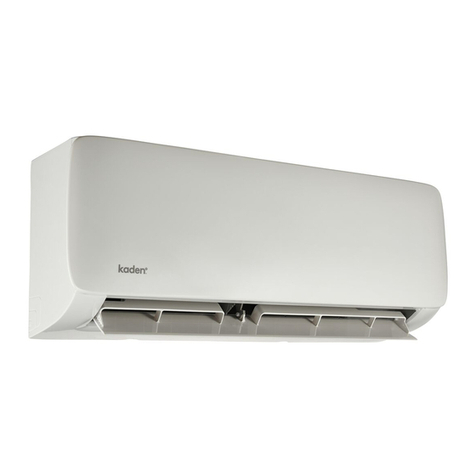
Kaden
Kaden KSI R32 owner's manual
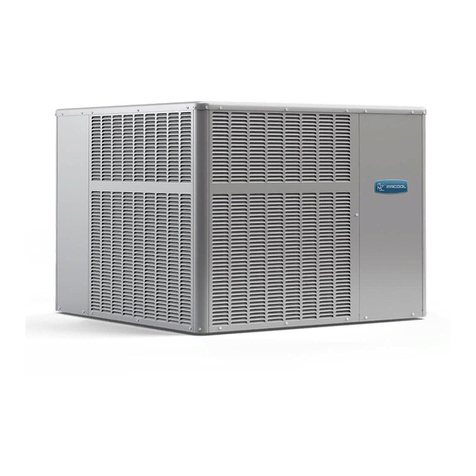
MrCool
MrCool Signature Series Owners & installation manual
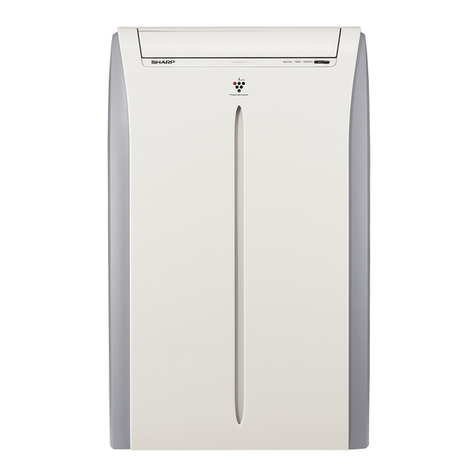
Sharp
Sharp CVP12PX - Ha Sh 11500 Btu Portable Air... Installation and operation manual
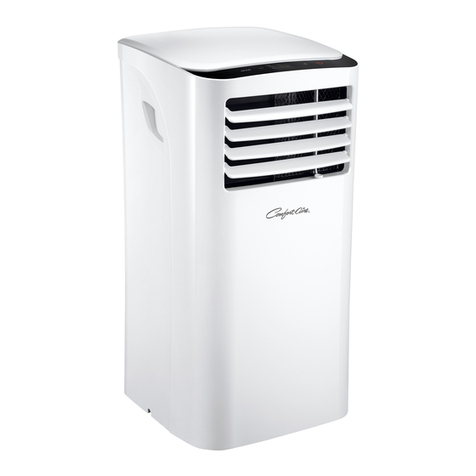
Mars
Mars COMFORT-AIRE PS-81G Owner's manual & installation manual
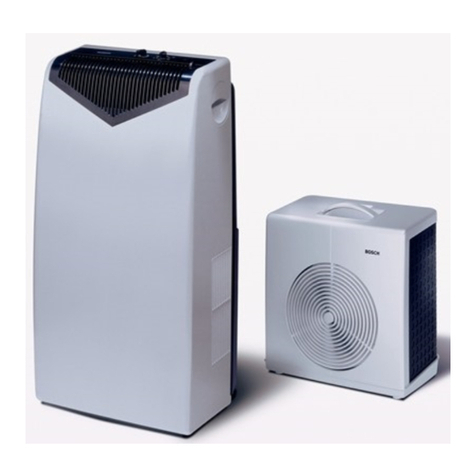
Bosch
Bosch B1 RKM 15001 Instructions for use
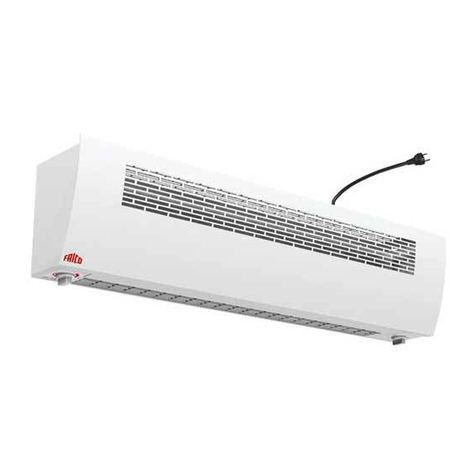
Frico
Frico AD100 Original instructions

Hitachi
Hitachi airHome 400 DJ Series Operation manual

Fedders
Fedders A6K32E7B user manual

Mitsubishi Electric
Mitsubishi Electric Mr. Slim MXZ-3A30NA installation manual

Samsung
Samsung AR18NSFPEWQNEU Service manual
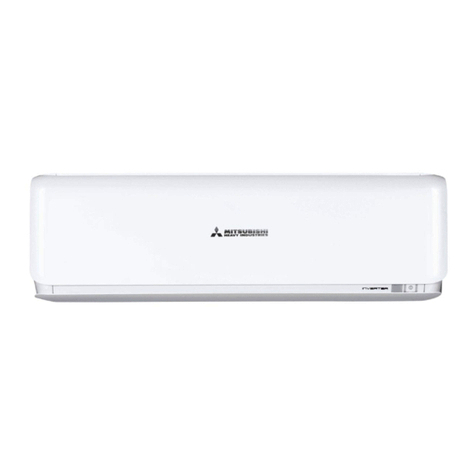
Mitsubishi Heavy Industries
Mitsubishi Heavy Industries SRK20ZSX-W Service manual

Sharp
Sharp AF-A7UA Operation manual
